It's close to the midway point in a campaign, called CaptureIndy, in which a publisher is collecting photographs from area photographers that reflect life and landmarks in the Greater Indianapolis Area. The images are to be included in a book and DVD.
CaptureIndy is not offering any compensation to photographers for their submissions, regardless of whether the images are published, but it is guaranteeing the shooters will retain all rights and ownership claims to the images.
Anyone -- even those who don't submit photos -- can vote (an indication of your approval or disapproval) for all the pictures submitted simply by creating a free account with minimal information at CaptureIndy.com. The rules sort of indicate that the votes won't hold full sway on which images are selected for the book/DVD, but I guess the project administrators feel voting is a way to A) steer them to the most popular images; 2) help them draw attention to the book/DVD and, probably, 3) drum up some sales. CaptureIndy is already accepting orders for the book, which retails for $30 (photo submitters get $5 discounts) until a certain cutoff date, after which the price goes up another $10.
I've submitted quite a few of my images to the campaign. I feel it's a way to get some exposure (excuse the pun) while getting to see the fine work of other area photographers. And of the latter, I have not been disappointed. I've already made contact with a few photographers whose work I've enjoyed seeing at the CaptureIndy site. Some of them have agreed to be profiled here as a future "Photographer in the Spotlight" subject, as I make an attempt to bring some deserving attention to the photographic skills in Indianapolis.
I am going to try and get the first area photographer lined up for the July "spotlight" feature, assuming everything falls together in time. But even if not, it's still exciting knowing there is abundant talent to appreciate in these parts.
Meanwhile ... if you haven't done so already ... please drop by CaptureIndy.com and check it out. Look up my submissions while you're there. If you have time, make your way through the various "chapters" (categories), which are "Scapes of all Sorts," "Everyday Life," "Friendly Faces," "Sports and Recreation," "Landmarks," "Arts and Culture," "Pets," and "Newsworthy" -- and if you have the time, go through the images one by one. Cast votes, if you feel so compelled.
Monday, June 29, 2009
Sunday, June 21, 2009
PP's Photographer in the Spotlight:
Chris Harris
 By day, Chris Harris works for the Colorado River Board of California, which strives to protect California's rights and interests in the resources provided by the Colorado River and t
By day, Chris Harris works for the Colorado River Board of California, which strives to protect California's rights and interests in the resources provided by the Colorado River and t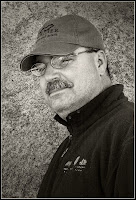 o represent California in discussions and negotiations regarding the Colorado River and its management. But when he's off the clock, Chris is drawn to the landscapes of the western United States, photographing deserts, lakes, preserves and other vistas that capture his eye, such as The Sentinel of Bear Mountain, the striking backlighted image you see at the top of this post.
o represent California in discussions and negotiations regarding the Colorado River and its management. But when he's off the clock, Chris is drawn to the landscapes of the western United States, photographing deserts, lakes, preserves and other vistas that capture his eye, such as The Sentinel of Bear Mountain, the striking backlighted image you see at the top of this post.
Chris has a particular fascination for deserts -- and black-and-white photography. "For me, black and white is a wonderful medium for capturing the interplay between light, shadows, and textures in the landscapes I spend time in," he says. Chris lives in the Santa Clarita Valley north of Los Angeles and makes a point to travel a lot in pursuit of his hobby.
I caught up with Chris in recent weeks to discuss his hobby and the endeavors associated with it:
Chris, when and how did you get into photography, and was it a gradual thing, or did you fall into it lock, stock and barrel?
As long as I can remember I have always been interested in photography; both the actual taking of photographs, as well as looking at photographs taken by others. I remember seeing some of the early “coffee table” books of photographs taken by Ansel Adams and Eliot Porter. As a young college student I always had a Sierra Club calendar hanging on the wall with photographs of beautiful and exotic landscapes from across North America or the world.
I think that when I first really became interested in taking more artistic photographs was in the mid-1970s when I was in the United States Coast Guard and was stationed in the eastern Bahamas on the island of San Salvador. My mother had given me an old Yashica 35mm SLR camera. I had great fun with that camera, and dabbled with black and white and slide film. I still have several old scrapbooks of photographs that I took during that tour of duty, and some of ’em aren’t half bad.
When the new er point-and-shoot film cameras started coming out in the late-80s and 90s, I tried a few, with mixed results. Finally, about five years ago, I got back into the SLRs again. This time, however, I made the leap to digital and purchased an Olympus Evolt E-500 kit at one of the big-box stores. I have never looked back at film again. I am having way too much fun with the digital camera, computer, and software.
er point-and-shoot film cameras started coming out in the late-80s and 90s, I tried a few, with mixed results. Finally, about five years ago, I got back into the SLRs again. This time, however, I made the leap to digital and purchased an Olympus Evolt E-500 kit at one of the big-box stores. I have never looked back at film again. I am having way too much fun with the digital camera, computer, and software.
 er point-and-shoot film cameras started coming out in the late-80s and 90s, I tried a few, with mixed results. Finally, about five years ago, I got back into the SLRs again. This time, however, I made the leap to digital and purchased an Olympus Evolt E-500 kit at one of the big-box stores. I have never looked back at film again. I am having way too much fun with the digital camera, computer, and software.
er point-and-shoot film cameras started coming out in the late-80s and 90s, I tried a few, with mixed results. Finally, about five years ago, I got back into the SLRs again. This time, however, I made the leap to digital and purchased an Olympus Evolt E-500 kit at one of the big-box stores. I have never looked back at film again. I am having way too much fun with the digital camera, computer, and software.
I see that, at your Lone Bear Images Web site, you describe yourself as a fine art landscape photographer. Do you pursue those kinds of images exclusively, or at least predominantly? If not, what other kinds of photography interests you? I notice there are some architectural images in your photo.net portfolio, for example (or do you consider that part of fine art landscape?)
Joe, I do primarily focus my photographic interests on landscape imagery. By way of background, I was born and raised in Montana and have always had a profound connection with the land. Additionally, most of my adult life I have had jobs in the great American west that has allowed me to work outside and travel a good deal. I am also a national/state park junkie and never pass up an opportunity to visit a park or wildlife refuge if I have half-a-chance.
Generally, I think my landscape photography represents an innate desire, on my part, to visually portray my personal interpretations 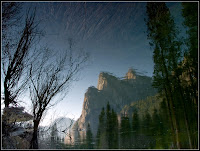 of the effect of the landscape upon me at that moment in time; if that makes any sense. I am very much a fan of the American “Hudson River School” of art that gave rise to such landscape artists like Thomas Cole, Frederic Edwin Church, Albert Bierstadt, and my personal favorite, Thomas Moran. This mid-19th century artistic movement produced pastoral landscape paintings that are very realistic and natural appearing. The landscape works of Bierstadt and Moran were virtually single-handedly responsible for the creation of Yellowstone and Yosemite National Parks. The “Hudson River School” continues to influence my landscape photography in my approach to scene composition, lighting conditions, and ultimately in my post-processing.
of the effect of the landscape upon me at that moment in time; if that makes any sense. I am very much a fan of the American “Hudson River School” of art that gave rise to such landscape artists like Thomas Cole, Frederic Edwin Church, Albert Bierstadt, and my personal favorite, Thomas Moran. This mid-19th century artistic movement produced pastoral landscape paintings that are very realistic and natural appearing. The landscape works of Bierstadt and Moran were virtually single-handedly responsible for the creation of Yellowstone and Yosemite National Parks. The “Hudson River School” continues to influence my landscape photography in my approach to scene composition, lighting conditions, and ultimately in my post-processing.
 of the effect of the landscape upon me at that moment in time; if that makes any sense. I am very much a fan of the American “Hudson River School” of art that gave rise to such landscape artists like Thomas Cole, Frederic Edwin Church, Albert Bierstadt, and my personal favorite, Thomas Moran. This mid-19th century artistic movement produced pastoral landscape paintings that are very realistic and natural appearing. The landscape works of Bierstadt and Moran were virtually single-handedly responsible for the creation of Yellowstone and Yosemite National Parks. The “Hudson River School” continues to influence my landscape photography in my approach to scene composition, lighting conditions, and ultimately in my post-processing.
of the effect of the landscape upon me at that moment in time; if that makes any sense. I am very much a fan of the American “Hudson River School” of art that gave rise to such landscape artists like Thomas Cole, Frederic Edwin Church, Albert Bierstadt, and my personal favorite, Thomas Moran. This mid-19th century artistic movement produced pastoral landscape paintings that are very realistic and natural appearing. The landscape works of Bierstadt and Moran were virtually single-handedly responsible for the creation of Yellowstone and Yosemite National Parks. The “Hudson River School” continues to influence my landscape photography in my approach to scene composition, lighting conditions, and ultimately in my post-processing.
Finally, as you have noticed, I do enjoy architecture; which is probably a nod to my late-grand father who was a Harvard-educated architect of long-standing in New England. I guess I do view architecture and its great and small structures as a part of the overall landscape. While I typically do not include human figures in my landscape images, I do, at times, and when appropriate, incorporate structures, be they new, modern, historic, or even prehistoric. Again, it probably has something to do with my interpretation of the relationship, or juxtaposition, between man and the natural world.
father who was a Harvard-educated architect of long-standing in New England. I guess I do view architecture and its great and small structures as a part of the overall landscape. While I typically do not include human figures in my landscape images, I do, at times, and when appropriate, incorporate structures, be they new, modern, historic, or even prehistoric. Again, it probably has something to do with my interpretation of the relationship, or juxtaposition, between man and the natural world.
 father who was a Harvard-educated architect of long-standing in New England. I guess I do view architecture and its great and small structures as a part of the overall landscape. While I typically do not include human figures in my landscape images, I do, at times, and when appropriate, incorporate structures, be they new, modern, historic, or even prehistoric. Again, it probably has something to do with my interpretation of the relationship, or juxtaposition, between man and the natural world.
father who was a Harvard-educated architect of long-standing in New England. I guess I do view architecture and its great and small structures as a part of the overall landscape. While I typically do not include human figures in my landscape images, I do, at times, and when appropriate, incorporate structures, be they new, modern, historic, or even prehistoric. Again, it probably has something to do with my interpretation of the relationship, or juxtaposition, between man and the natural world.
Can you point to any photographers who influenced you ... or your work? If so, how?
As I mentioned above, I probably owe my first inspirational allegiance to the great landscape painters of the Romantic Period, i.e., John Constable, John M.W. Turner, and then the Hudson River School; but the great photographers that are of constant inspiration to me are Ansel Adams and Eliot Porter. Obviously, I love Ansel Adams’ great black and white landscape work throughout the west, particularly here in my home-state of California.
There are two books in my home library that I make a point of carefully re-reading and studying at least twice a year, both by Adams: (1) “The Negative” and (2) “Examples: The Making of 40 Photographs.” Before my big trips each year, I will sit down and slowly page through these books and reacquaint my brain with Adams’ thoughts on composition, exposure values, tonal range, etc. In summary, Adams has influenced my black and white work and compositions.
Eliot Porter has taken me down another track and has caused me to take great interest in the art of the “intim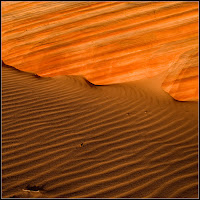 ate landscape”, in other words, finding and making images of interesting compositions just a few feet from the end of the lens (such as Microscape VI, from Valley of Fire State Park in Nevada, at left). Finding these intimate landscapes, or “microscapes”, as I call them, has kind of evolved into a signature image for me of late.
ate landscape”, in other words, finding and making images of interesting compositions just a few feet from the end of the lens (such as Microscape VI, from Valley of Fire State Park in Nevada, at left). Finding these intimate landscapes, or “microscapes”, as I call them, has kind of evolved into a signature image for me of late.
 ate landscape”, in other words, finding and making images of interesting compositions just a few feet from the end of the lens (such as Microscape VI, from Valley of Fire State Park in Nevada, at left). Finding these intimate landscapes, or “microscapes”, as I call them, has kind of evolved into a signature image for me of late.
ate landscape”, in other words, finding and making images of interesting compositions just a few feet from the end of the lens (such as Microscape VI, from Valley of Fire State Park in Nevada, at left). Finding these intimate landscapes, or “microscapes”, as I call them, has kind of evolved into a signature image for me of late.
Finally, with the advent of the internet, and the ability to find and post photography online, I have found an unlimited amount of resources and inspiration; but I probably spend most of my online time on Photo.net. On Photo.net I have several favorites as well; including the photography of Leo Burkey, Mark Geistweite, David Speight, and David Roossien. In all honesty, each of them has contributed something significant toward the development of my own style. For example, Leo Burkey and David Roossien have helped me develop my black and white and intimate landscape style; while David Speight and Mark Geistweite, as masters of the broad sweeping and dynamically rich color landscapes, have also stylistically influenced me.
What kind of equipment do you use? Do you have a favorite lens -- or other accessory -- that you use for your landscapes? I notice, for example, a lot of your skies have strong definitions -- in contrast or color -- and wondered if you were a frequent user of filters -- polarizer, neutral density or color?
Currently, for all of my photographic adventures, I utilize a digital Olympus Evolt E-500 camera in manual priority mode, a selection of lenses, a ball-head and carbon-fiber tripod, and a Pentax 1-degree digital spot-meter. My absolute all-time favorite lens is a Zuiko 14-54mm; and it is on my camera probably 95% of the time. I periodically use a circular polarizing filter; and also use various graduated and reverse-graduated neutral density filters and holder system. Over time, I have tended to use the circular polarizing filter less and less; as much the same effect can be achieved with multiple exposures and then careful blending of images in post-processing. One aspect of my photography is constant though, I always use a ballhead, tripod, the digital spot-meter, and a remote shutter release.
When I first went through your portfolio at photo.net, I think I was most taken by your black-and-white images. Did you use to shoot a lot of black and white on film? And how do you decide which frames you will convert to B/W of those you shoot in digital color?
I did shoot a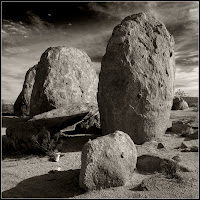 lot of black and white film in my younger days ... without a lot of success, I might add. Nowadays, when in the field, I typically pre-visualize whether an image I am after will be presented, in its final form, as a color or black and white image.
lot of black and white film in my younger days ... without a lot of success, I might add. Nowadays, when in the field, I typically pre-visualize whether an image I am after will be presented, in its final form, as a color or black and white image.
 lot of black and white film in my younger days ... without a lot of success, I might add. Nowadays, when in the field, I typically pre-visualize whether an image I am after will be presented, in its final form, as a color or black and white image.
lot of black and white film in my younger days ... without a lot of success, I might add. Nowadays, when in the field, I typically pre-visualize whether an image I am after will be presented, in its final form, as a color or black and white image.
When targeting a black and white image, I very carefully meter the entire scene, and try to ensure that I have a full-range of exposure values; i.e., kind of my adaption of Adams’ “Zone System” for my digital camera and my skills. If I have taken the high and low exposure values, with thorough metering, into account in my overall exposure (or exposures, if I take multiples), I can then typically represent a full range of tones in the finished processed image.
In the desert southwest, I find that black and white images somehow seem to accentuate the play of light, tones, and the harsh ecological conditions that exist in these unique habitats. Conversely, when photographing in Glacier National Park or Great Smoky Mountains National Park, with all of the lush vegetation, I find that color is my preferred medium for showcasing the beauty of these landscapes. As a rule, with few exceptions, I generally prefer my black and white work to my color work.
How much post-processing do you invest in when dealing with your images? Are you one who advocates "less is best," or would you consider yourself a "Photoshop phreak"?
I am probably in a middle-camp when it comes to image post-processing. I use Adobe Photoshop Custom Suites 3 (CS3) for all of my post-processing. I utilize a fairly structured workflow that I have developed and adapted over the past few years. This workflow changes somewhat with each new release of Photoshop. I also keep a notebook in which I record all of my activities related to the post-processing of an image from download through final printing.
I shoot all of my images in Olympus camera raw format (ORF), and down-load them onto the computer via Adobe Bridge, and after some basic tweaking in Bridge the image is then opened in Photoshop CS3 for processing. I do take multiple exposures and then blend them together in CS3 using smart objects and layer masks. With each image, I generally make a curves adjustment to fix white and black points and bump the contrast. All of my black and white conversions are done in CS3 with the Black and White adjustment layer feature. To finish the image I’ll apply an Unsharp Mask, and run any desired toning actions (e.g., Ektalure cream, or Selenium; which imitate the look of the old photographic papers).
Finally, I do not send my images out for printing any longer. I do all of my own printing on an Epson Stylus Photo 2200 printer, and typically print on Harman or Ilford papers. With a little work, I am constantly amazed at the overall image and print quality I can obtain using this printer and these marvelous papers.
What do you look for in a landscape when you're trying to spy one? Is it light? Shadows? Angles? Juxtaposition? All of the above? Or does an idea just hit you as you survey the territory?
Generally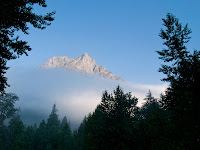 , when in a landscape environment where I know I want to make an image or two, I have an idea of what I’m after; and I’ll try and put myself in a position to create that image. The other option is more serendipitous; where you come onto something that just jumps out you, and you have to set up quickly to nail it. I love light-play and do try and target that as much as possible. For me, light, textures, contrasts, tones, and geometry are all very important elements to include in any image.
, when in a landscape environment where I know I want to make an image or two, I have an idea of what I’m after; and I’ll try and put myself in a position to create that image. The other option is more serendipitous; where you come onto something that just jumps out you, and you have to set up quickly to nail it. I love light-play and do try and target that as much as possible. For me, light, textures, contrasts, tones, and geometry are all very important elements to include in any image.
 , when in a landscape environment where I know I want to make an image or two, I have an idea of what I’m after; and I’ll try and put myself in a position to create that image. The other option is more serendipitous; where you come onto something that just jumps out you, and you have to set up quickly to nail it. I love light-play and do try and target that as much as possible. For me, light, textures, contrasts, tones, and geometry are all very important elements to include in any image.
, when in a landscape environment where I know I want to make an image or two, I have an idea of what I’m after; and I’ll try and put myself in a position to create that image. The other option is more serendipitous; where you come onto something that just jumps out you, and you have to set up quickly to nail it. I love light-play and do try and target that as much as possible. For me, light, textures, contrasts, tones, and geometry are all very important elements to include in any image.
I would imagine that the drive to photograph landscapes would give you the itch to travel a lot. Have you? How extensively, and where, would you say, you captured your most technically satisfying images, and where -- if it's different -- would you say you felt most profoundly affected (or moved) by the landscape you were photographing? Are there many places you haven't been to where you'd really like to indulge your craft?
You are right, Joe, travel is a crucial aspect of my landscape photography. I plan my trips each year quite carefully. I do a lot of research with books, maps, and use on-line resources. If I am going back to an area previously visited, I have a much better sense of what I want to do and potential opportunities. If it is a new area, I usually take a day or two and do some pretty intensive reconnaissance to better understand what opportunities exist and how long it takes me to move from point-to-point.
I have made some wonderful images in many places, but a few of my favorite areas include Yosemite, Glacier, Death Valley, Joshua Tree, and Great Smoky Mountains National Parks. With my parents living south of Tucson, Arizona; I am able to go into Saguaro National Park several times a year. I always buy the annual “National Parks and Federal Recreational Lands” pass each year, which gets me into any federal lands fee area and is a bargain at $80.
I would s ay that I have captured some of my most artistically and technically satisfying images in Death Valley and Glacier National Parks. For example some of my sand dune shots or the “moving rocks” at the Racetrack (left, Still-Life at the Racetrack) in Death Valley National Park have been well received by my peers. I love Yosemite National Park, but it is very, very difficult to set yourself apart in subject and style from all of the other superb photography that has been generated there. When I visit Yosemite, or other locales that are heavily photographed, I try and concentrate on finding unique images like my ‘microscapes’. In other words, you just have to work a little harder at finding something a little different from the obligatory Half Dome or El Capitan photograph.
ay that I have captured some of my most artistically and technically satisfying images in Death Valley and Glacier National Parks. For example some of my sand dune shots or the “moving rocks” at the Racetrack (left, Still-Life at the Racetrack) in Death Valley National Park have been well received by my peers. I love Yosemite National Park, but it is very, very difficult to set yourself apart in subject and style from all of the other superb photography that has been generated there. When I visit Yosemite, or other locales that are heavily photographed, I try and concentrate on finding unique images like my ‘microscapes’. In other words, you just have to work a little harder at finding something a little different from the obligatory Half Dome or El Capitan photograph.
 ay that I have captured some of my most artistically and technically satisfying images in Death Valley and Glacier National Parks. For example some of my sand dune shots or the “moving rocks” at the Racetrack (left, Still-Life at the Racetrack) in Death Valley National Park have been well received by my peers. I love Yosemite National Park, but it is very, very difficult to set yourself apart in subject and style from all of the other superb photography that has been generated there. When I visit Yosemite, or other locales that are heavily photographed, I try and concentrate on finding unique images like my ‘microscapes’. In other words, you just have to work a little harder at finding something a little different from the obligatory Half Dome or El Capitan photograph.
ay that I have captured some of my most artistically and technically satisfying images in Death Valley and Glacier National Parks. For example some of my sand dune shots or the “moving rocks” at the Racetrack (left, Still-Life at the Racetrack) in Death Valley National Park have been well received by my peers. I love Yosemite National Park, but it is very, very difficult to set yourself apart in subject and style from all of the other superb photography that has been generated there. When I visit Yosemite, or other locales that are heavily photographed, I try and concentrate on finding unique images like my ‘microscapes’. In other words, you just have to work a little harder at finding something a little different from the obligatory Half Dome or El Capitan photograph.
As far as places that I’d love to photograph, I have a few regions in mind. I have always wanted to make images in Acadia National Park in Maine; in Olympic National Park in Washington, New England in the fall, the Sand Hills region of Nebraska, Michigan’s Upper Peninsula, and Redwoods National Park in northern California. I generally try and pick off a new region to visit and photograph every year or two; so I’ve plenty of time to hit these and find some new ones as well.
Here's a wide-open question: What aspect of your work gives you the most satisfaction?
I think the element of my photography that has yielded the most satisfaction is finding myself in the right place at the right time 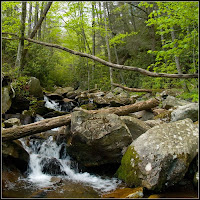 and making a fine image that I am exceedingly proud of. Those moments, as one might imagine, are somewhat few and far between; even with the extensive trip planning that I do. You know the old adage, “Even a blind squirrel finds a nut now and then.”
and making a fine image that I am exceedingly proud of. Those moments, as one might imagine, are somewhat few and far between; even with the extensive trip planning that I do. You know the old adage, “Even a blind squirrel finds a nut now and then.”
 and making a fine image that I am exceedingly proud of. Those moments, as one might imagine, are somewhat few and far between; even with the extensive trip planning that I do. You know the old adage, “Even a blind squirrel finds a nut now and then.”
and making a fine image that I am exceedingly proud of. Those moments, as one might imagine, are somewhat few and far between; even with the extensive trip planning that I do. You know the old adage, “Even a blind squirrel finds a nut now and then.”
As you well know, a lot of things have to line up to capture that one really terrific image: location, lighting conditions, sky conditions, the right equipment, proper exposure, and, finally, post-processing skills. Being able to recognize and take advantage of a serendipitous convergence of these important elements has allowed me to capture and produce a few images that are enormously satisfying.
Have you ever had your images on display in a gallery, or in a show? Do you sell your work? If not, would you like to?
No (laughing out loud), I have never had my images on display in a gallery or a show. I should think it a great honor if it ever happened. When asked, I have given prints of my images away to family and friends, and that is very gratifying. Unfortunately, I haven't a marketing bone in my body; I'm much too interested in taking photographs to really bother trying to sell them.
Fortunately, I have a wonderful day job that pays the bills and keeps my family in house and home.
See more of Chris Harris' work at the following Web sites:
Labels:
black-and-white,
chris harris,
CS3,
desert,
Evolt E-500,
intimate,
landscape,
lone bear images,
meter,
national parks,
Olympus,
photo.net,
PITS,
travel,
zone system
Sunday, June 14, 2009
Asiatic lilies make their appearance
 My asiatic lilies are blooming. They've opened to provide these splendid pink and yellow vistas in my back yard, and as you can tell from some of the periphery content in the images, there are many more buds bursting to bloom.
My asiatic lilies are blooming. They've opened to provide these splendid pink and yellow vistas in my back yard, and as you can tell from some of the periphery content in the images, there are many more buds bursting to bloom.This is quite a difference from last year, the flowers' first summer after a fall 2007 bulb planting, when each of these plants rose to about half the heights you see here ... and showed and bloomed a mere, solitary one (1) flower. I kid you not.
What a difference a strong year and cold season revitalization will make.

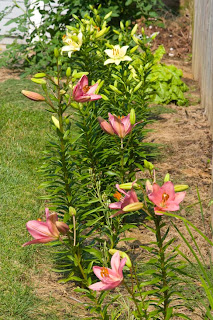



Labels:
2009,
asiatic,
asiatic lilies,
circular garden,
lilies,
lily
Friday, June 5, 2009
An evening at the playground
Subscribe to:
Posts (Atom)





